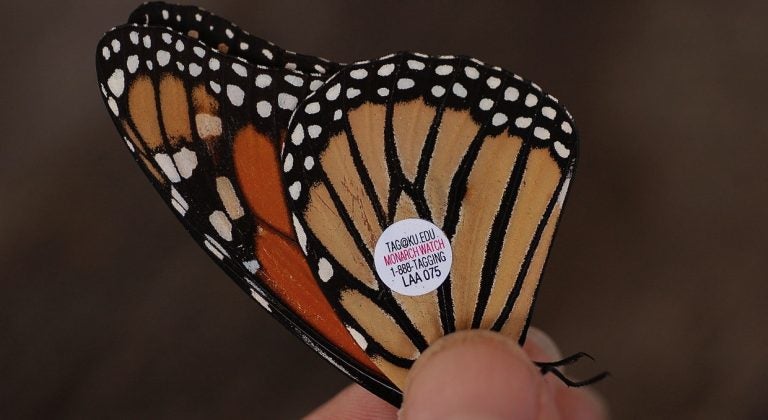With monarch butterflies on the move, annual Cape May census is underway

A monarch butterfly tagged through the Cape May Bird Observatory's effort is shown in this 2008 photo. / Via Wikimedia Commons
Keep your eyes on the milkweed: The yearly migration of monarch butterflies is making its way through the Cape May area, and the annual census conducted by the Cape May Bird Observatory’s Monarch Monitoring Project is in full swing.
It’s an especially close-watched year, as predictions and some observations so far have been for a “dismally small” year for the number of southward migrating monarchs. Like every species, monarchs are feeling the effects of climate change. And the development of places where milkweed — the one plant on which their caterpillars will feed and the only one to which they’ll attach eggs — once grew.
VIEW: Animated map showing the northward progress of adult monarch butterflies for Spring, 2013.
In Cape May, it’s been slow going so far, but numbers are beginning to pick up.
Samm Wehman is the field technician gathering the actual research this year, though according to the Monarch Monitoring Project blog she’s keeping on it, there hasn’t always been much to count. [Do check out her awesome Monarch manicure, though!]
“It’s pretty slow,” she said Wednesday night, as she updated this week’s numbers, which show an average of 22.11 monarchs per hour as of Oct. 2.
That’s up from the previous weeks this year, but compared to the same week in some other years, it’s painfully small. Numbers can vary wildly from year to year, as migrations are speeded up or delayed by weather and other factors, making it difficult to predict a peak — though a peak time, where hourly monarch sightings are in the hundreds — usually comes.
In Cape May, Wehman said, there is a theory that monarchs may not be emerging from their chrysalises until later because researchers’ work with public awareness, combined with a large number of preserved wildlife areas and gardens, has made it too nice to leave.
“We do know htat in Cape May we are definitely doing something right,” Wehman said.
The entire Mexico-to-East Coast roundtrip actually involves several generations of monarchs, who are born and die along the way.
“Something triggers that next generation of monarchs that it is not just about reproduction, it’s time to migrate,” Wehman said. “But those same [monarchs] who started here and made their way to Mexico won’t come back here.”
Since 1992, the project has gathered data between Sept. 1 and Oct. 31, through field observations made several times a day by a person who drives a 5-mile route three times each day. With tagging, data is collected through a system of monarch waystations and compiled at the Monarch Watch project at Kansas University.
WHYY is your source for fact-based, in-depth journalism and information. As a nonprofit organization, we rely on financial support from readers like you. Please give today.


